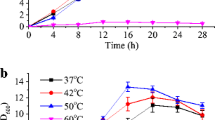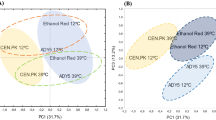Abstract
During fed-batch cultivation of Escherichia coli K-12, the proteomic response to a temperature downshift from 37 to 20°C was quantitatively monitored and analyzed by using two-dimensional electrophoresis. When the temperature of exponentially growing E. coli K-12 culture was downshifted to 20°C, the synthesis level of 57 intracellular proteins showed significant changes for a prolonged period of time, compared to the fed-batch culture controlled at 37°C. Thus, these proteins are regarded as important stress proteins responsive to cold shock, which were analyzed by using matrix-assisted laser desorption/ionization time-of-flight mass spectrometry and identified using the E. coli SWISS-2DPAGE database. Most of the identified proteins were shown to be involved in energy metabolism, several cellular molecule biosynthetic pathways and catabolism, cell processes, flagellar biosynthesis and motility, and protein translation and folding. The systematic approach to the monitoring of proteomic responses and the detailed analysis results reported in this article would be useful in understanding the metabolic adaptation to lowered culture temperature and designing efficient fermentation strategies for the production of recombinant proteins and metabolites using E. coli strains.


Similar content being viewed by others
References
Charollais J, Dreyfus M, Iost I (2004) CsdA, a cold-shock RNA helicase from Escherichia coli, is involved in the biogenesis of 50S ribosomal subunit. Nucleic Acids Res 32:2751–2759
Durrschmid K, Marzban G, Durrschmid E, Striedner G, Clementschitsch F, Cserjan-Puschmann M, Bayer K (2003) Monitoring of protein profiles for the optimization of recombinant fermentation processes using public domain databases. Electrophoresis 24:303–310
Etchegaray JP, Inouye M (1999) CspA, CspB, CspG, major cold shock proteins of Escherichia coli, are induced at low temperature under condition that completely block protein synthesis. J Bacteriol 181:1827–1830
Jones CJ, Aizawa SI (1991) The bacterial flagellum and flagellar motor: structure, assembly and function. Adv Microb Physiol 32:109–172
Jones G, VanBogelen RA, Neidhardt FC (1987) Induction of protein in response to low temperature in Escherichia coli. J Bacteriol 169:2092–2095
Jones PG, Cashel M, Glaser G, Neidhardt FC (1992) Function of a relaxed-like state following temperature downshifts in Escherichia coli, cspA. J Bacteriol 174:3903–3914
Kandror O, Goldberg AL (1997) Trigger factor is induced upon cold shock and enhances viability of Escherichia coli at low temperatures. Proc Natl Acad Sci U S A 94:4978–4981
Kandror O, Sherman M, Rhode M, Goldberg AL (1995) Trigger factor is involved in GroEL-dependent protein degradation in Escherichia coli and promotes binding of GeoEL to unfolded proteins. EMBO J 14:6021–6027
Kandror O, Sherman M, Moerschell R, Goldberg AL (1997) Trigger factor associates with GroEL in vivo and promotes its binding to certain polypeptides. J Biol Chem 272:1730–1734
Kim YH, Park JS, Cho JY, Cho KM, Park YH, Lee J (2004) Proteomic response analysis of a threonine-overproducing mutant of Escherichia coli. Biochem J 381:823–829
Kumar JK, Tabor S, Richardson CC (2004) Proteomic analysis of thioredoxin-targeted proteins in Escherichia coli. Proc Natl Acad Sci U S A 101:3759–3764
Lee J, Saraswat V, Koh I, Song KB, Park YH, Rhee SK (2001) Secretory production of Arthrobacter levan fructotransferase from recombinant Escherichia coli. FEMS Microbiol Lett 295:127–132
Lelivelt MJ, Kawula TH (1995) Hsc66, an Hsp70 homolog in Escherichia coli, is induced by cold shock but not by heat shock. J Bacteriol 177:4900–4907
Majoul T, Bancel E, Triboi E, Hamida JB, Branlard G (2003) Proteomic analysis of the effect of heat stress on hexaploid wheat grain: characterization of heat-responsive proteins from total endosperm. Proteomics 3:175–183
Maki JA, Schnobrich DJ, Culver GM (2002) The DnaK chaperone system facilitates 30S ribosomal subunit assembly. Mol Cell 10:129–138
Maurer LM, Yohannes E, Bondurant SS, Radmacher M, Slonczewski JL (2005) pH regulates genes for flagellar motility, catabolism, and oxidative stress in Escherichia coli K-12. J Bacteriol 187:304–319
Perrot F, Hebraud M, Junter GA, Jouenne T (2000) Protein synthesis in Escherichia coli at 4°C. Electrophoresis 21:1625–1629
Phadtare S, Inouye M (2004) Genome-wide transcriptional analysis of the cold shock response in wild-type and cold-sensitive, quadruple-csp-deletion strains of Escherichia coli. J Bacteriol 186:7007–7014
Polissi A, Laurentis WD, Zangrossi S, Briani F, Longhi V, Pesole G, Deho G (2003) Changes in Escherichia coli transcriptome during acclimatization at low temperature. Res Microbiol 154:573–580
Qing G, Ma LC, Khorchid A, Swapna GVT, Mal TK, Takayama MM, Xia B, Phadtare S, Ke H, Acton T, Montelione GT, Ikura M, Inouye M (2004) Cold-shock induced high-yield protein production in Escherichia coli. Nat Biotechnol 22:877–882
Sperandio V, Torres AG, Kaper JB (2002) Quorum sensing Escherichia coli regulators B and C (QseBC): a novel two-component regulatory system involved in the regulation of flagella and motility by quorum sensing in E. coli. Mol Microbiol 43:809–821
Tang H, Billings S, Wang X, Sharp L, Blair DF (1995) Regulated underexpression and overexpression of the FliN protein and evidence for an interaction between FliN and FliM in the flagellar motor. J Bacteriol 177:3496–3503
Thieringer HA, Jones PG, Inouye M (1998) Cold shock and adaptation. BioEssays 20:49–57
Vasina JA, Peterson MS, Baneyx F (1998) Scale-up and optimization of the low-temperature inducible cspA promoter system. Biotechnol Prog 14:714–721
Yamanaka K, Inouye M (2001) Induction of CspA, an E. coli major cold-shock protein, upon nutritional upshift at 37°C. Genes Cells 6:279–290
Acknowledgements
This work was supported by Korea Research Foundation Grant (KRF-2002-041-D00196).
Author information
Authors and Affiliations
Corresponding author
Rights and permissions
About this article
Cite this article
Kim, YH., Han, K.Y., Lee, K. et al. Proteome response of Escherichia coli fed-batch culture to temperature downshift. Appl Microbiol Biotechnol 68, 786–793 (2005). https://doi.org/10.1007/s00253-005-0053-3
Received:
Revised:
Accepted:
Published:
Issue Date:
DOI: https://doi.org/10.1007/s00253-005-0053-3




